2005 VOLVO XC90 spare tire
[x] Cancel search: spare tirePage 129 of 263
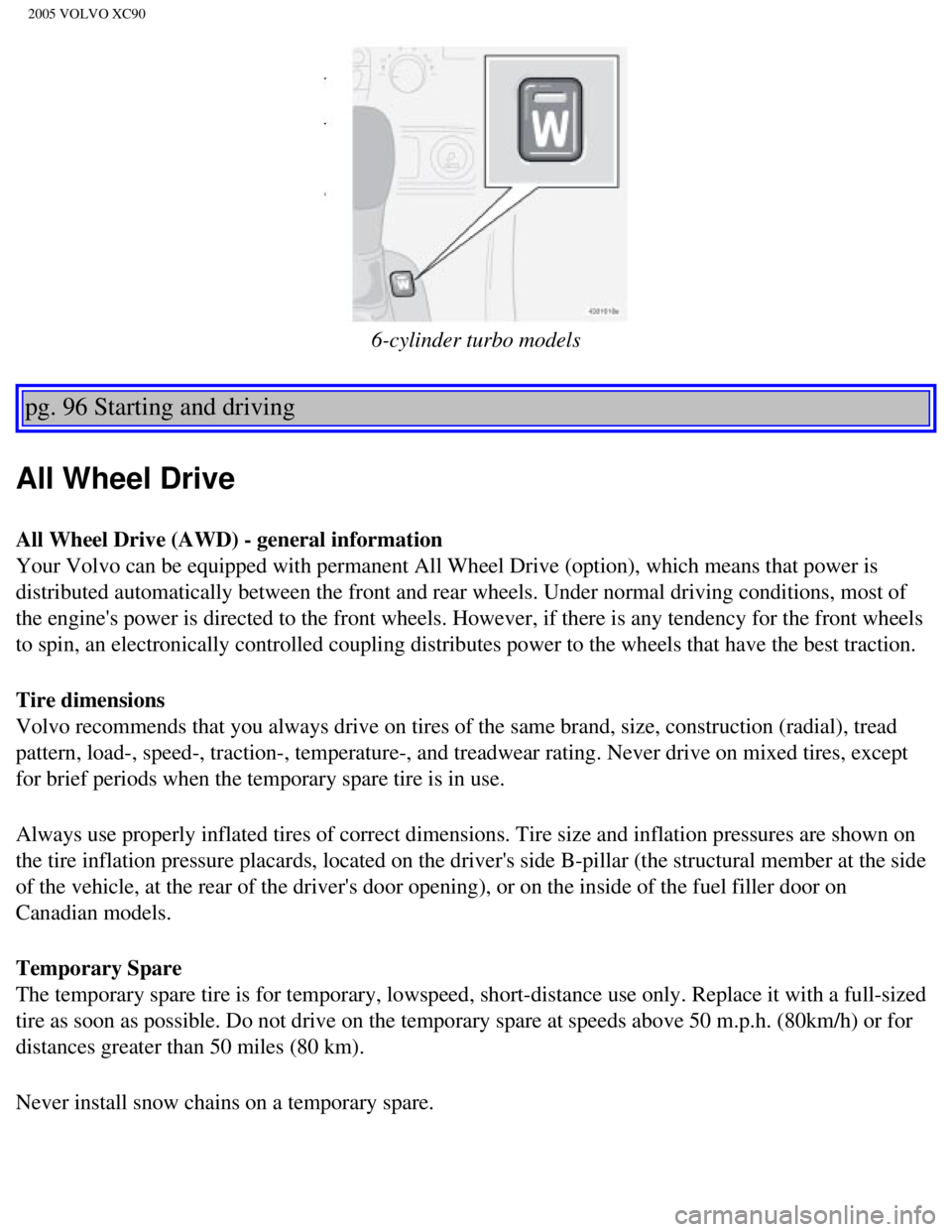
2005 VOLVO XC90
6-cylinder turbo models
pg. 96 Starting and driving
All Wheel Drive
All Wheel Drive (AWD) - general information
Your Volvo can be equipped with permanent All Wheel Drive (option), wh\
ich means that power is
distributed automatically between the front and rear wheels. Under norma\
l driving conditions, most of
the engine's power is directed to the front wheels. However, if there is\
any tendency for the front wheels
to spin, an electronically controlled coupling distributes power to the \
wheels that have the best traction.
Tire dimensions
Volvo recommends that you always drive on tires of the same brand, size,\
construction (radial), tread
pattern, load-, speed-, traction-, temperature-, and treadwear rating. N\
ever drive on mixed tires, except
for brief periods when the temporary spare tire is in use.
Always use properly inflated tires of correct dimensions. Tire size and \
inflation pressures are shown on
the tire inflation pressure placards, located on the driver's side B-pil\
lar (the structural member at the side
of the vehicle, at the rear of the driver's door opening), or on the in\
side of the fuel filler door on
Canadian models.
Temporary Spare
The temporary spare tire is for temporary, lowspeed, short-distance use \
only. Replace it with a full-sized
tire as soon as possible. Do not drive on the temporary spare at speeds \
above 50 m.p.h. (80km/h) or for
distances greater than 50 miles (80 km).
Never install snow chains on a temporary spare.
file:///K|/ownersdocs/2005/2005_XC90/05xc90_06a.htm (15 of 16)12/30/20\
06 4:42:33 PM
Page 148 of 263

2005 VOLVO XC90
l Examine tires carefully (the spare tire as well), and replace those th\
at are worn. Check tire pressures.
l The brakes, front wheel alignment, and steering gear should be checked b\
y your Volvo retailer only.
l Check all lights, including high beams.
l Reflective warning triangles are legally required in some states/provinc\
es.
l Have a word with your Volvo retailer if you intend to drive in countries\
where it may be difficult to
obtain the correct fuel.
l Consider your destination. If you will be driving through an area where \
snow or ice are likely to
occur, consider snow tires.
* To prevent injury from contact with hot surfaces, do not inspect your \
vehicle's transmission fluid
yourself. Have your vehicle's transmission fluid level inspected by a qu\
alified Volvo service technician.
Contents | Top of Page
file:///K|/ownersdocs/2005/2005_XC90/05xc90_06b.htm (18 of 18)12/30/20\
06 4:42:35 PM
Page 155 of 263
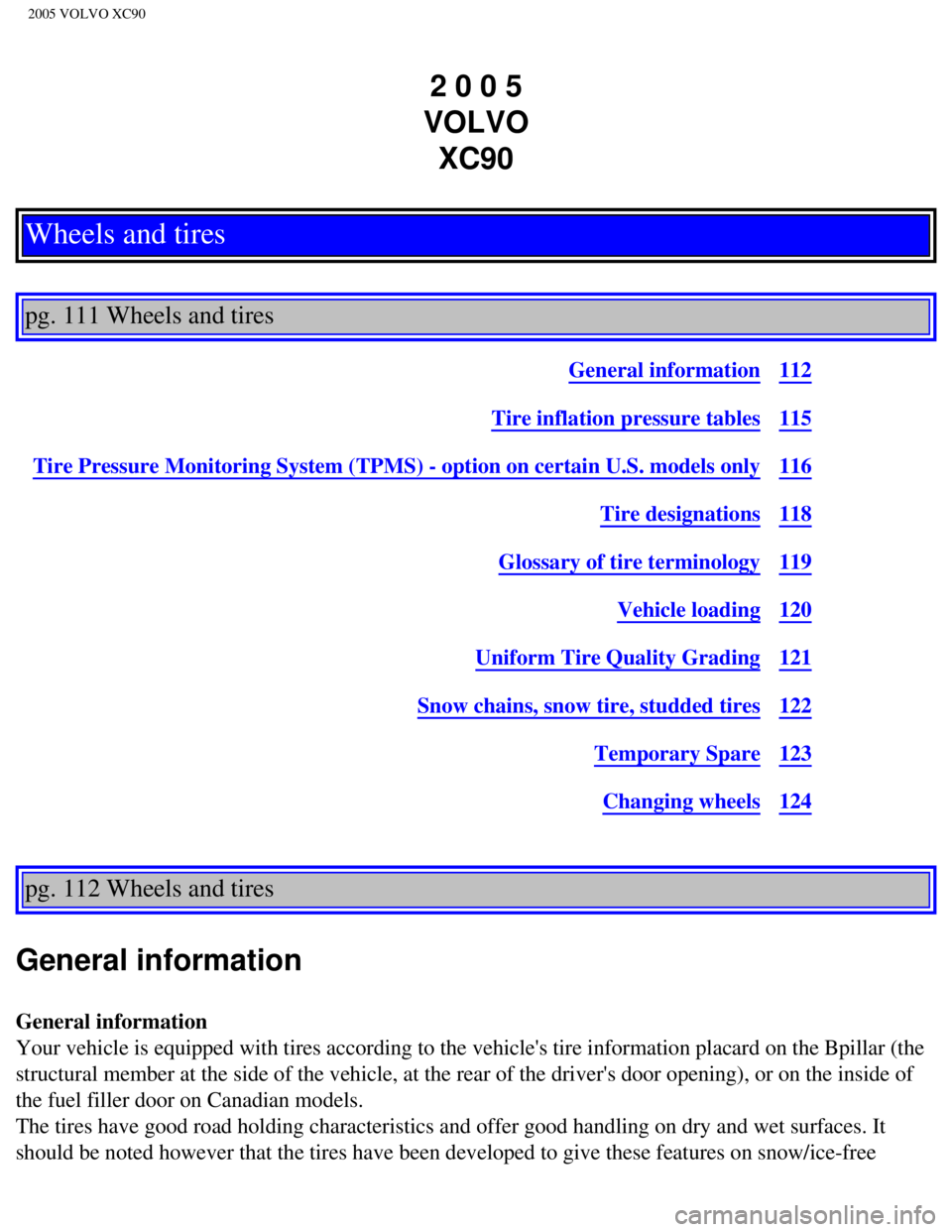
2005 VOLVO XC90
2 0 0 5
VOLVO XC90
Wheels and tires
pg. 111 Wheels and tires
General information112
Tire inflation pressure tables115
Tire Pressure Monitoring System (TPMS) - option on certain U.S. models\
only116
Tire designations118
Glossary of tire terminology119
Vehicle loading120
Uniform Tire Quality Grading121
Snow chains, snow tire, studded tires122
Temporary Spare123
Changing wheels124
pg. 112 Wheels and tires
General information
General information
Your vehicle is equipped with tires according to the vehicle's tire info\
rmation placard on the Bpillar (the
structural member at the side of the vehicle, at the rear of the driver'\
s door opening), or on the inside of
the fuel filler door on Canadian models.
The tires have good road holding characteristics and offer good handling\
on dry and wet surfaces. It
should be noted however that the tires have been developed to give these\
features on snow/ice-free
file:///K|/ownersdocs/2005/2005_XC90/05xc90_08.htm (1 of 17)12/30/2006\
4:42:37 PM
Page 159 of 263
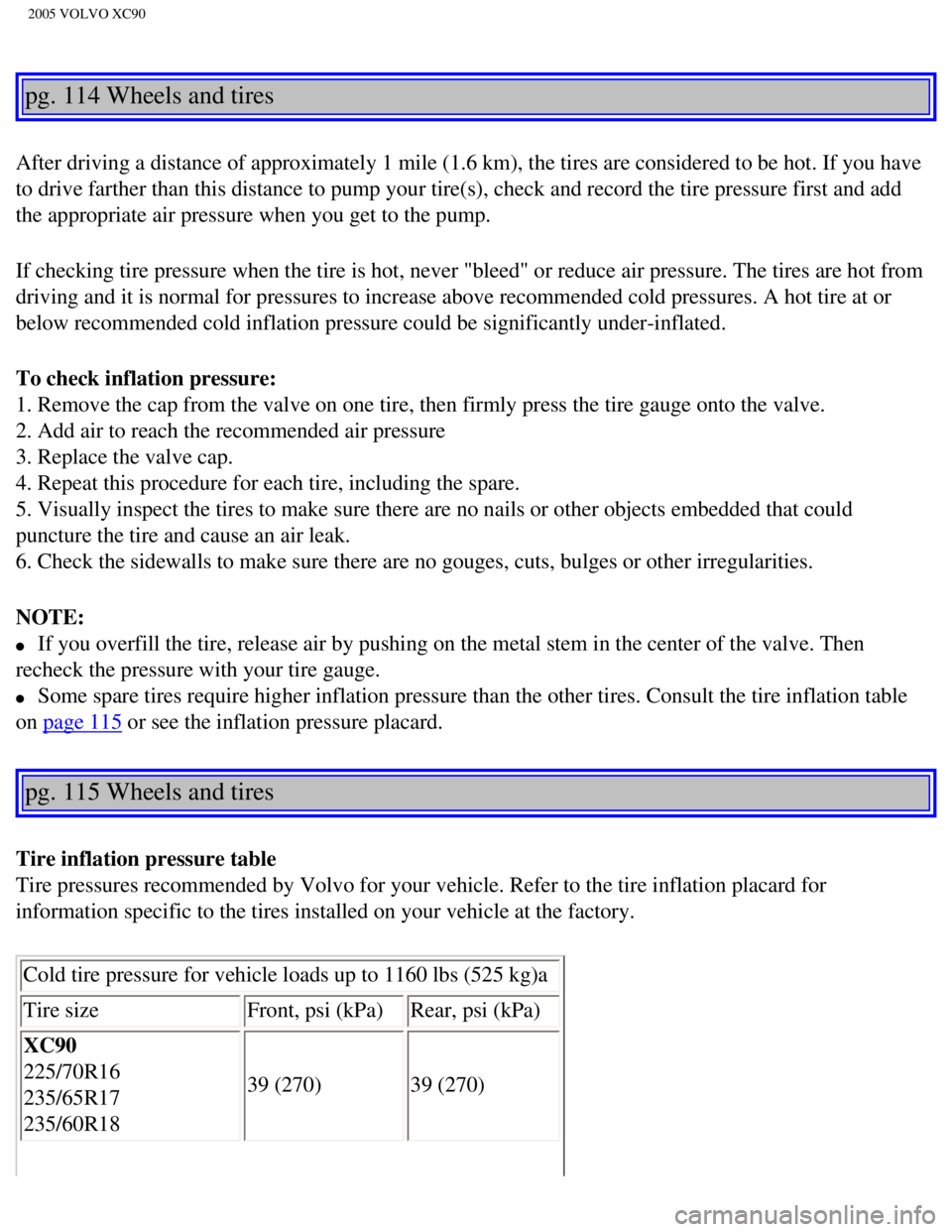
2005 VOLVO XC90
pg. 114 Wheels and tires
After driving a distance of approximately 1 mile (1.6 km), the tires a\
re considered to be hot. If you have
to drive farther than this distance to pump your tire(s), check and re\
cord the tire pressure first and add
the appropriate air pressure when you get to the pump.
If checking tire pressure when the tire is hot, never "bleed" or reduce \
air pressure. The tires are hot from
driving and it is normal for pressures to increase above recommended col\
d pressures. A hot tire at or
below recommended cold inflation pressure could be significantly under-i\
nflated.
To check inflation pressure:
1. Remove the cap from the valve on one tire, then firmly press the tire\
gauge onto the valve.
2. Add air to reach the recommended air pressure
3. Replace the valve cap.
4. Repeat this procedure for each tire, including the spare.
5. Visually inspect the tires to make sure there are no nails or other o\
bjects embedded that could
puncture the tire and cause an air leak.
6. Check the sidewalls to make sure there are no gouges, cuts, bulges or\
other irregularities.
NOTE:
l If you overfill the tire, release air by pushing on the metal stem in th\
e center of the valve. Then
recheck the pressure with your tire gauge.
l Some spare tires require higher inflation pressure than the other tires.\
Consult the tire inflation table
on
page 115 or see the inflation pressure placard.
pg. 115 Wheels and tires
Tire inflation pressure table
Tire pressures recommended by Volvo for your vehicle. Refer to the tire \
inflation placard for
information specific to the tires installed on your vehicle at the facto\
ry. Cold tire pressure for vehicle loads up to 1160 lbs (525 kg)a
Tire size Front, psi (kPa) Rear, psi (kPa)
XC90
225/70R16
235/65R17
235/60R18 39 (270)
39 (270)
file:///K|/ownersdocs/2005/2005_XC90/05xc90_08.htm (5 of 17)12/30/2006\
4:42:37 PM
Page 160 of 263

2005 VOLVO XC90
Temporary spare tire
T155/85R18 61 (420)
61 (420)
a. These weights include the weight of all occupants of the car plus car\
go.
WARNING!
- Never install wheel/tire combinations larger than 18" on your Volvo XC\
90. Doing so will adversely
affect your vehicle's handling and stability, and safety system performa\
nce.
- Any damage caused by installation of unapproved wheel/tire size combin\
ations will not be covered
by your new vehicle warranty. Volvo assumes no responsibility for death,\
injury, or expenses that
may result from such installations.
pg. 116 Wheels and tires
Tire Pressure Monitoring System (TPMS) - option on certain U.S. models\
only
The tire pressure monitoring system uses sensors mounted in the tire val\
ves to check inflation pressure
levels. When the vehicle is moving at a speed of 20 mph (30 km/h) or f\
aster, these sensors transmit
inflation pressure data to a receiver located in the vehicle.
USA - FCC ID: MRXTG315AM04 This device complies with part 15 of the FCC \
rules. Operation is
subject to the following conditions: (1) This device may not cause har\
mful interference, and (2) this
device must accept any interference received, including interference tha\
t may cause undesired operation.
When low inflation pressure is detected, TPMS will light up the tire pre\
ssure warning light ( ) in the
instrument panel, and will display a message in the text window. The wor\
ding of this message is
determined by the degree of inflation pressure loss.
When the tire pressure monitoring system warning light is on, one or mor\
e of your tires is significantly
under-inflated. You should stop and check your tires as soon as possible\
, and inflate them to the proper
pressure as indicated on the vehicle's tire information placard.
Driving on a significantly under-inflated tire causes the tire to overhe\
at and can lead to tire failure.
Under-inflation also reduces fuel efficiency and tire tread life, and ma\
y affect the vehicle's handling and
stopping ability. Each tire, including the spare, should be checked mont\
hly when cold and set to the
recommended inflation pressure as specified in the vehicle placard and o\
wner's manual.
NOTE: TPMS indicates low tire pressure but does not replace normal tire maint\
enance. For information
on correct tire pressure, please refer to the table on
page 115, or consult your Volvo retailer.
file:///K|/ownersdocs/2005/2005_XC90/05xc90_08.htm (6 of 17)12/30/2006\
4:42:37 PM
Page 161 of 263

2005 VOLVO XC90
Erasing warning messages
When a low tire pressure warning message has been displayed, and the tir\
e pressure warning light has
come on:
1. Use a tire pressure gauge to check the inflation pressure of all four\
tires.
2. Re-inflate the tire(s) to the correct pressure (consult the tire p\
ressure placard or the table on
page 115).
3. Drive the car for at least one minute at a speed of 20 mph (30 km/h)\
or faster. This will erase the
warning text and the warning light will go out.
WARNING!
Incorrect inflation pressure could lead to tire failure, resulting in a \
loss of control of the
vehicle.
Changing tires
Please note the following when changing or replacing the factory install\
ed TPMS wheels/tires on the
vehicle:
Only the factory-mounted wheels are equipped with TPMS sensors in the va\
lves.
If the vehicle is equipped with a temporary spare tire, this tire does n\
ot have a TPMS sensor.
If, for example, winter wheels/tires are used that are not equipped with\
TPMS sensors, the message
TIRE PRESSURE SYSTEM SERVICE REQUIRED will be displayed after the car ha\
s been driven for
several minutes at approximately 35 mph (50 km/h) or faster.
This message will remain on until wheels with TPMS sensors are mounted o\
n the vehicle and it has been
driven for at least one minute at a speed of 20 mph (30 km/h) or faste\
r.
pg. 117 Wheels and tires
TPMS valves can be fitted on winter wheels or full-size spare wheels/tir\
es. Consult your Volvo retailer.
CAUTION:
When inflating tires with TPMS valves, press the pump's mouthpiece strai\
ght onto the valve to help
avoid bending or otherwise damaging the valve.
file:///K|/ownersdocs/2005/2005_XC90/05xc90_08.htm (7 of 17)12/30/2006\
4:42:37 PM
Page 168 of 263
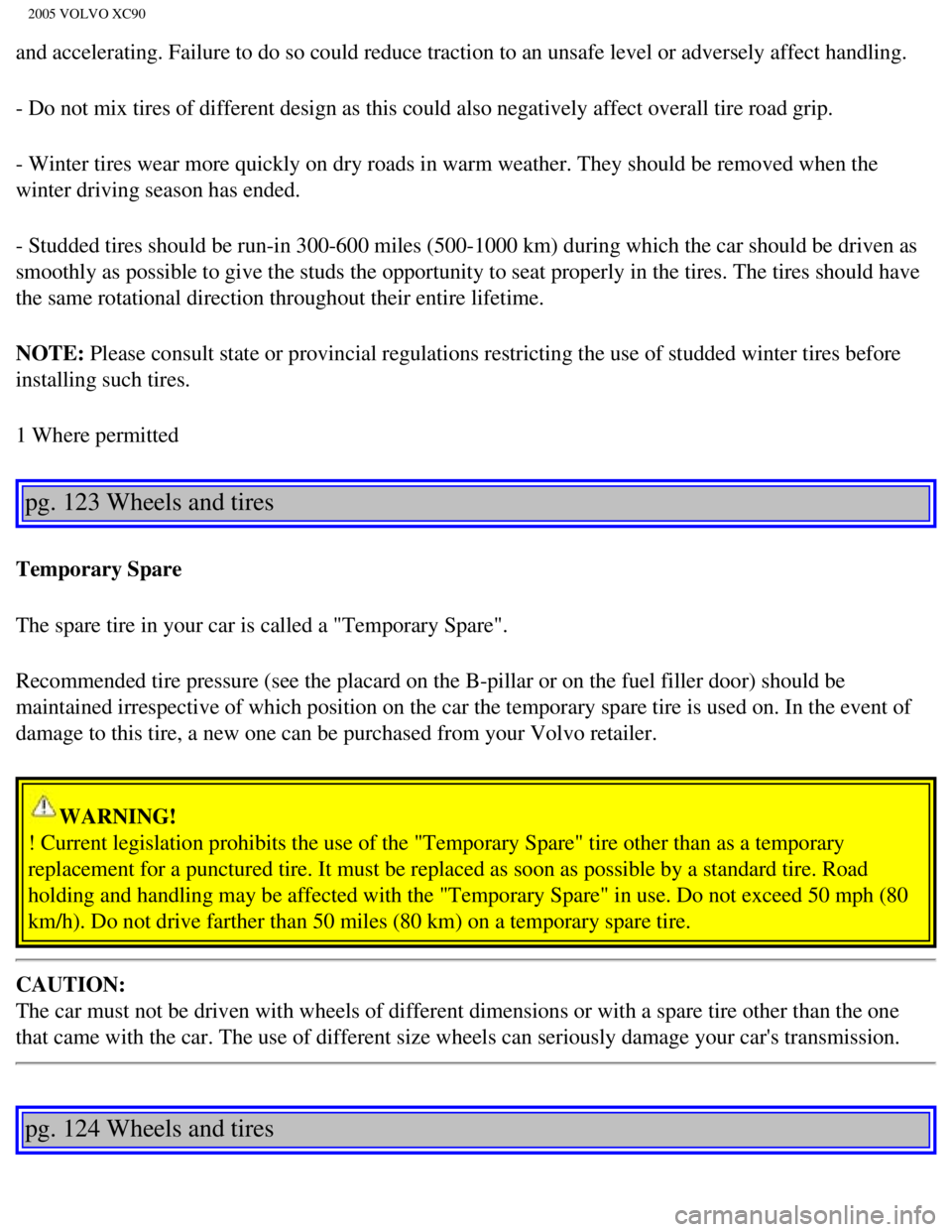
2005 VOLVO XC90
and accelerating. Failure to do so could reduce traction to an unsafe le\
vel or adversely affect handling.
- Do not mix tires of different design as this could also negatively aff\
ect overall tire road grip.
- Winter tires wear more quickly on dry roads in warm weather. They shou\
ld be removed when the
winter driving season has ended.
- Studded tires should be run-in 300-600 miles (500-1000 km) during wh\
ich the car should be driven as
smoothly as possible to give the studs the opportunity to seat properly \
in the tires. The tires should have
the same rotational direction throughout their entire lifetime.
NOTE: Please consult state or provincial regulations restricting the use of st\
udded winter tires before
installing such tires.
1 Where permitted
pg. 123 Wheels and tires
Temporary Spare
The spare tire in your car is called a "Temporary Spare".
Recommended tire pressure (see the placard on the B-pillar or on the fu\
el filler door) should be
maintained irrespective of which position on the car the temporary spare\
tire is used on. In the event of
damage to this tire, a new one can be purchased from your Volvo retailer\
.
WARNING!
! Current legislation prohibits the use of the "Temporary Spare" tire ot\
her than as a temporary
replacement for a punctured tire. It must be replaced as soon as possibl\
e by a standard tire. Road
holding and handling may be affected with the "Temporary Spare" in use. \
Do not exceed 50 mph (80
km/h). Do not drive farther than 50 miles (80 km) on a temporary spar\
e tire.
CAUTION:
The car must not be driven with wheels of different dimensions or with a\
spare tire other than the one
that came with the car. The use of different size wheels can seriously d\
amage your car's transmission.
pg. 124 Wheels and tires
file:///K|/ownersdocs/2005/2005_XC90/05xc90_08.htm (14 of 17)12/30/200\
6 4:42:37 PM
Page 170 of 263
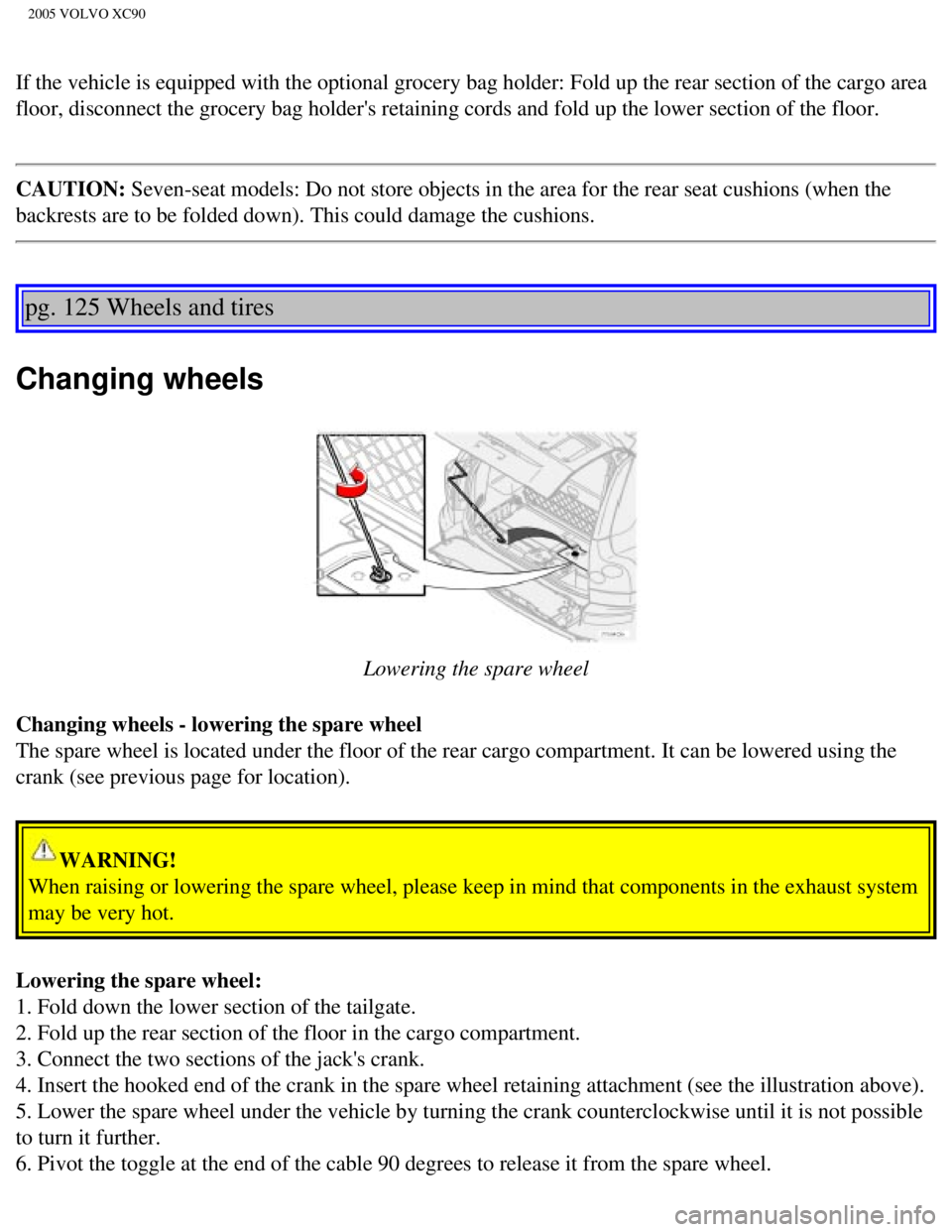
2005 VOLVO XC90
If the vehicle is equipped with the optional grocery bag holder: Fold up\
the rear section of the cargo area
floor, disconnect the grocery bag holder's retaining cords and fold up t\
he lower section of the floor.
CAUTION: Seven-seat models: Do not store objects in the area for the rear seat c\
ushions (when the
backrests are to be folded down). This could damage the cushions.
pg. 125 Wheels and tires
Changing wheels
Lowering the spare wheel
Changing wheels - lowering the spare wheel
The spare wheel is located under the floor of the rear cargo compartment\
. It can be lowered using the
crank (see previous page for location).
WARNING!
When raising or lowering the spare wheel, please keep in mind that compo\
nents in the exhaust system
may be very hot.
Lowering the spare wheel:
1. Fold down the lower section of the tailgate.
2. Fold up the rear section of the floor in the cargo compartment.
3. Connect the two sections of the jack's crank.
4. Insert the hooked end of the crank in the spare wheel retaining attac\
hment (see the illustration above).
5. Lower the spare wheel under the vehicle by turning the crank counterc\
lockwise until it is not possible
to turn it further.
6. Pivot the toggle at the end of the cable 90 degrees to release it fro\
m the spare wheel.
file:///K|/ownersdocs/2005/2005_XC90/05xc90_08.htm (16 of 17)12/30/200\
6 4:42:37 PM